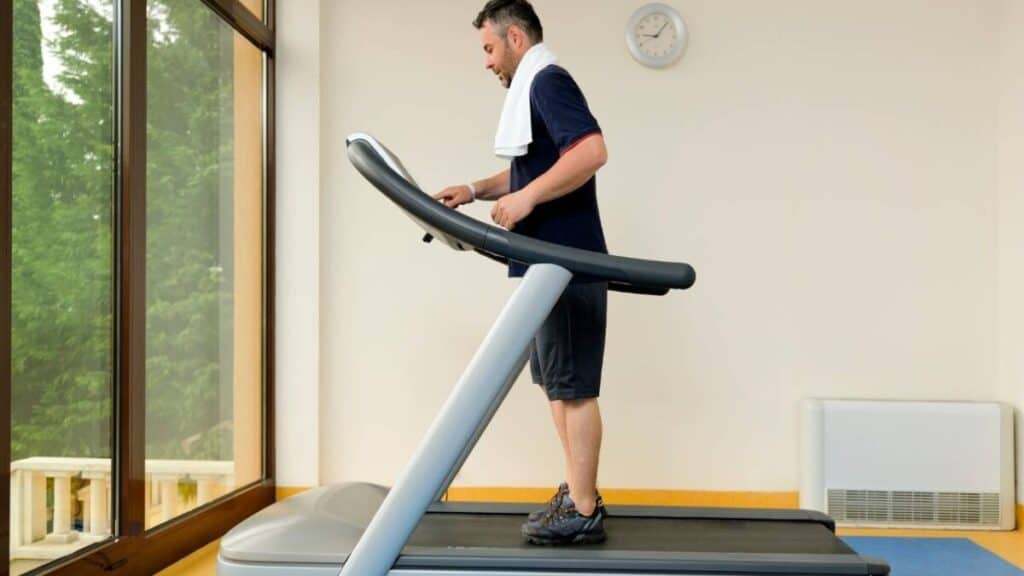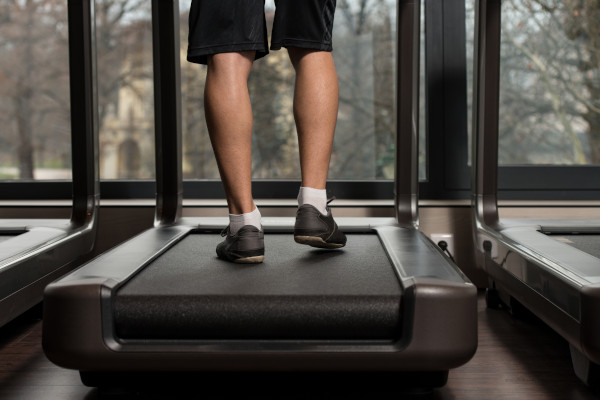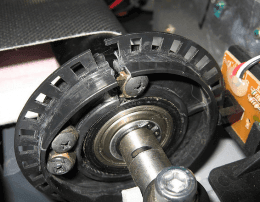Are you frustrated with your treadmill suddenly stopping after just 20 minutes of use? It can be quite annoying when you’re in the midst of a great workout and then your machine unexpectedly shuts down. In this article, we will explore the possible reasons behind this issue and provide you with some helpful tips to prevent and fix it. So, if you’re tired of dealing with this problem, keep reading to find out what might be causing it and how you can overcome it for a smooth and uninterrupted workout experience.
Common Causes of a Treadmill Stopping After 20 Minutes
If you’ve ever experienced the frustration of your treadmill stopping after just 20 minutes of use, you’re not alone. This is a common issue that many treadmill owners face, and there can be several reasons behind it. In this article, we will explore the various potential causes and provide you with practical solutions to get your treadmill back up and running smoothly.

This image is property of fitnessgearshub.com.
Overheating of Motor
One of the most prevalent causes of a treadmill stopping after 20 minutes is the overheating of the motor. When the motor gets too hot, it can shut down as a protective measure. There are a few factors that can contribute to motor overheating:
Motor Overload
Excessive usage or running at high speeds for an extended period can put too much strain on the motor, causing it to overheat. To prevent this, try varying your workout intensity or consider taking breaks during your treadmill sessions to give the motor time to cool down.
Insufficient Ventilation
If your treadmill is placed in an area with poor ventilation, the motor may not be able to dissipate heat efficiently. Make sure that your treadmill is positioned in a well-ventilated area, away from walls or furniture that can obstruct airflow. Regularly clean the motor area to remove dust and debris that can impede proper ventilation.
Dusty Motor
Accumulated dust and debris can hamper the cooling process of the motor. It’s essential to clean the motor area regularly, ensuring that there is no build-up of dust or debris. Use a soft, lint-free cloth or a vacuum cleaner with a brush attachment to gently remove any dirt from the motor and fan blades.
Faulty Motor Controller
Another possible cause of your treadmill stopping after 20 minutes is a malfunctioning motor controller. The motor controller regulates the speed and power of the motor. If it becomes faulty, your treadmill may shut down. Common issues with the motor controller include:
Defective Motor Controller
Sometimes, the motor controller can be defective straight from the factory or due to wear and tear over time. If you suspect that the motor controller is the problem, contact the manufacturer or a professional technician to diagnose and replace the faulty component.
Damaged Circuit Board
The circuit board within the motor controller can sustain damage from electrical surges, excessive heat, or physical impact. A damaged circuit board can disrupt the communication between the motor and the controller, leading to the treadmill abruptly stopping. To address this issue, you may need to have the circuit board repaired or replaced.

This image is property of img.livestrong.com.
Inadequate Power Supply
Insufficient power supply can cause your treadmill to stop prematurely. Two potential power-related issues are:
Insufficient Voltage
If the voltage reaching your treadmill is lower than the required specifications, it may not have enough power to operate continuously. Ensure that your treadmill is plugged into a dedicated outlet that provides the correct voltage. Avoid using extension cords or sharing outlets with other high-powered appliances that could affect the voltage supply.
Incorrect Power Output
Mismatched power ratings between your treadmill and the power outlet can lead to power supply issues. Check the specifications of your treadmill and make sure the power outlet supports the required output. Using a voltage regulator or contacting an electrician to assess and adjust the power supply can help resolve this problem.
Tripped Safety Key
Treadmills are equipped with safety features to protect users from potential accidents. One of these safety features is the safety key. When the safety key is dislodged or the magnetic switch malfunctions, it can cause the treadmill to come to a sudden halt. Look out for the following potential causes of a tripped safety key:
Loose, Damaged, or Disconnected Safety Key
Ensure that the safety key is securely attached to the treadmill console. If it’s loose or damaged, it may trigger the safety mechanism and stop the treadmill. Check the key for any signs of wear and tear and replace it if necessary. Additionally, make sure the key is properly connected to the console to ensure it functions correctly.
Faulty Magnetic Switch
The magnetic switch, which is activated when the safety key is inserted, can sometimes malfunction. This can lead to unexpected shutdowns during your workout. If you suspect that the magnetic switch is faulty, reach out to the manufacturer or a certified technician to evaluate and repair or replace the switch as needed.

This image is property of conditionandnutrition.com.
Incorrect Treadmill Setup
Proper setup and assembly of your treadmill are essential for its optimal performance. Incorrect setup can result in various issues that cause the treadmill to stop after 20 minutes. Consider the following factors when setting up your treadmill:
Improper Assembly
If your treadmill was not assembled correctly, it may lead to issues such as misaligned components or loose connections. Review the user manual carefully and ensure that all parts are securely and accurately installed. If you’re unsure about the assembly process, contact the manufacturer or seek professional assistance.
Uneven Surface
Placing your treadmill on an uneven surface can cause it to wobble or become unstable during use. This can trigger the safety mechanism and halt the treadmill operation. Choose a flat and level surface for your treadmill, preferably with a non-slip mat to enhance stability and prevent accidents. Use a spirit level to check and adjust the alignment if necessary.
Misaligned Rollers
Misaligned rollers can cause the walking or running belt to slip, resulting in an interrupted workout. Check the alignment of the rollers and adjust them as needed. Refer to the user manual or contact the manufacturer for specific instructions on aligning the rollers properly.
Worn or Loose Belt
The condition of the treadmill belt plays a crucial role in its performance and longevity. A worn or loose belt can lead to various treadmill malfunctions, including sudden stops. Consider the following possibilities related to belt issues:
Belt Slippage
If the treadmill belt slips while in use, it can trigger a safety mechanism that stops the treadmill. Check that the belt is adequately tensioned by referring to the user manual. If the belt tension is incorrect, consult the manual or contact the manufacturer for guidance on proper adjustment.
Excessive Belt Tension
On the other hand, having the belt overly tightened can cause unnecessary strain on the motor and other components, potentially leading to premature shutdowns. Follow the manufacturer’s guidelines for proper belt tension and make adjustments accordingly.
Worn Motor Drive Belt
The motor drive belt, which connects the motor to the treadmill’s belt, can wear out over time. A worn motor drive belt can cause the treadmill to stop unexpectedly. Examine the motor drive belt periodically and replace it if you notice signs of wear, cracking, or significant stretching.
Worn Walking Belt
The walking belt, the part of the treadmill that you directly walk or run on, can also deteriorate with extended use. A worn walking belt may become loose or develop uneven surfaces, causing the treadmill to stop during your workouts. Regularly inspect the walking belt for signs of wear and replace it if necessary.

This image is property of funonfoot.com.
Lack of Lubrication
Proper lubrication is crucial to maintain a smooth and friction-free movement of the treadmill belt. Insufficient lubrication or a dry, dirty belt can result in increased friction, overheating, and eventual shutdowns. Consider the following lubrication-related issues:
Dry or Dirty Belt
Dust, debris, and lack of lubrication can cause the treadmill belt to become dry and dirty. This increases friction and can lead to early motor failure and sudden stops. Clean the belt regularly, removing any debris or dust particles. Additionally, apply lubricant specifically designed for treadmills to ensure smooth belt movement.
Insufficient Lubrication
If your treadmill’s belt is not adequately lubricated, it can cause excessive friction between the belt and the deck, resulting in motor stress and, eventually, shutdowns. Follow the manufacturer’s guidelines on lubrication frequency and use a suitable treadmill lubricant to maintain optimal performance.
Electronic Sensor Malfunction
Treadmills rely on various electronic sensors to monitor and control their speed, incline, and other functions. Malfunctioning sensors can disrupt the normal operation of the treadmill, causing it to stop unexpectedly. Consider the following sensor-related issues:
Faulty Speed Sensor
The speed sensor, which measures the speed of the treadmill belt, can malfunction due to damage or wear and tear. A faulty speed sensor may cause the treadmill to stop abruptly. Consult the user manual or contact the manufacturer to identify the sensor’s location and determine if it needs repair or replacement.
Malfunctioning Incline Sensor
If your treadmill offers incline adjustments, a malfunctioning incline sensor can cause the machine to stop after 20 minutes. The sensor may fail to detect the correct incline position, triggering a shutdown. Check the user manual for instructions on locating and troubleshooting the incline sensor or seek professional assistance.

This image is property of img.livestrong.com.
Software or Firmware Issues
Modern treadmills often feature advanced technology and onboard software for various functions and programs. Software or firmware glitches can occasionally occur, leading to unexpected shutdowns. Consider the following possibilities related to software or firmware problems:
Software Updates
Check if there are any software updates available for your treadmill model. Manufacturers often release updates to address known issues or improve performance. Visit the manufacturer’s website or contact their customer support for information on updating the treadmill software and firmware.
Resetting the Treadmill
In some cases, resetting the treadmill to its default settings can resolve software-related issues. Consult the user manual for instructions on resetting your specific treadmill model. Before performing a reset, back up any personal data or profiles stored on the machine.
Wiring Problems
Issues with the treadmill’s wiring can disrupt the electrical flow and cause unexpected shutdowns. Consider the following wiring-related possibilities:
Loose or Damaged Wiring Connections
Check for loose or damaged wiring connections throughout the treadmill. Loose wires or connectors can interrupt the electrical flow, leading to the treadmill stopping. Inspect the wiring carefully, ensuring that all connections are secure and free from damage. If you spot any issues, contact a professional technician to repair or replace the affected wiring.
Short Circuits
Short circuits in the electrical system of your treadmill can cause it to shut down abruptly. Inspect the wiring and electrical components for any signs of short circuits, such as burned or melted insulation. If you suspect a short circuit, it’s essential to seek professional assistance to diagnose and resolve the issue safely.
Corroded Wires
Moisture or exposure to high humidity can cause wires to corrode over time, leading to electrical disruptions. Regularly inspect the treadmill’s wiring for any signs of corrosion, such as greenish or powdery deposits. Replace any corroded wires promptly to prevent further damage and keep the treadmill running smoothly.
In conclusion, a treadmill stopping after 20 minutes can be quite frustrating, but it’s important to identify the underlying cause to effectively address the issue. Overheating of the motor, faulty motor controllers, inadequate power supply, tripped safety keys, incorrect treadmill setup, worn or loose belts, lack of lubrication, electronic sensor malfunctions, software or firmware issues, and wiring problems are all potential culprits. By following the troubleshooting steps provided for each possible cause, you can pinpoint the problem and take the necessary steps to get your treadmill back on track for uninterrupted workouts. Remember to consult your treadmill’s user manual or reach out to the manufacturer or a professional technician for specific guidance on diagnosing and resolving any issues. Stay motivated, and keep running towards your fitness goals!





